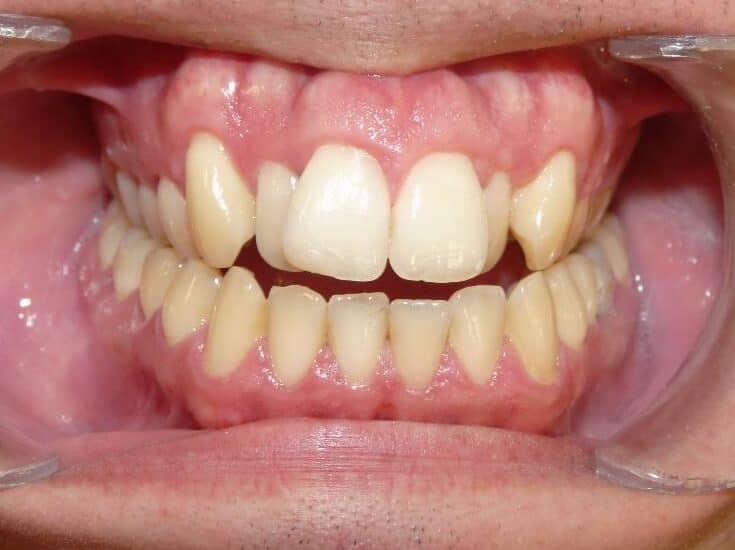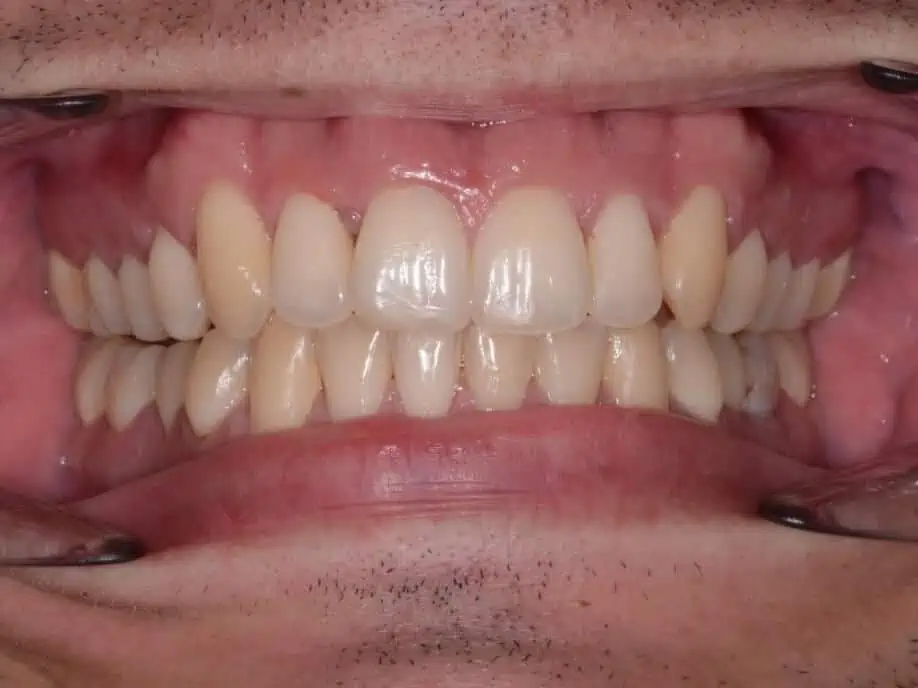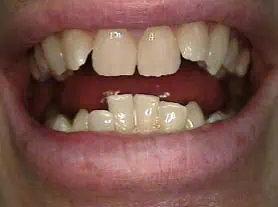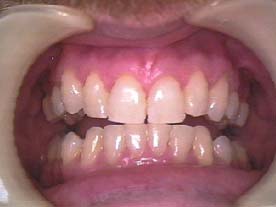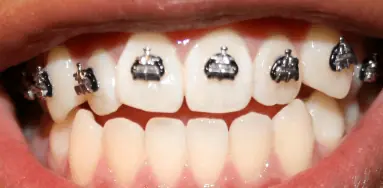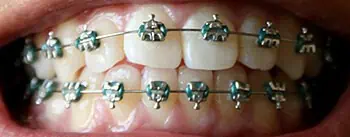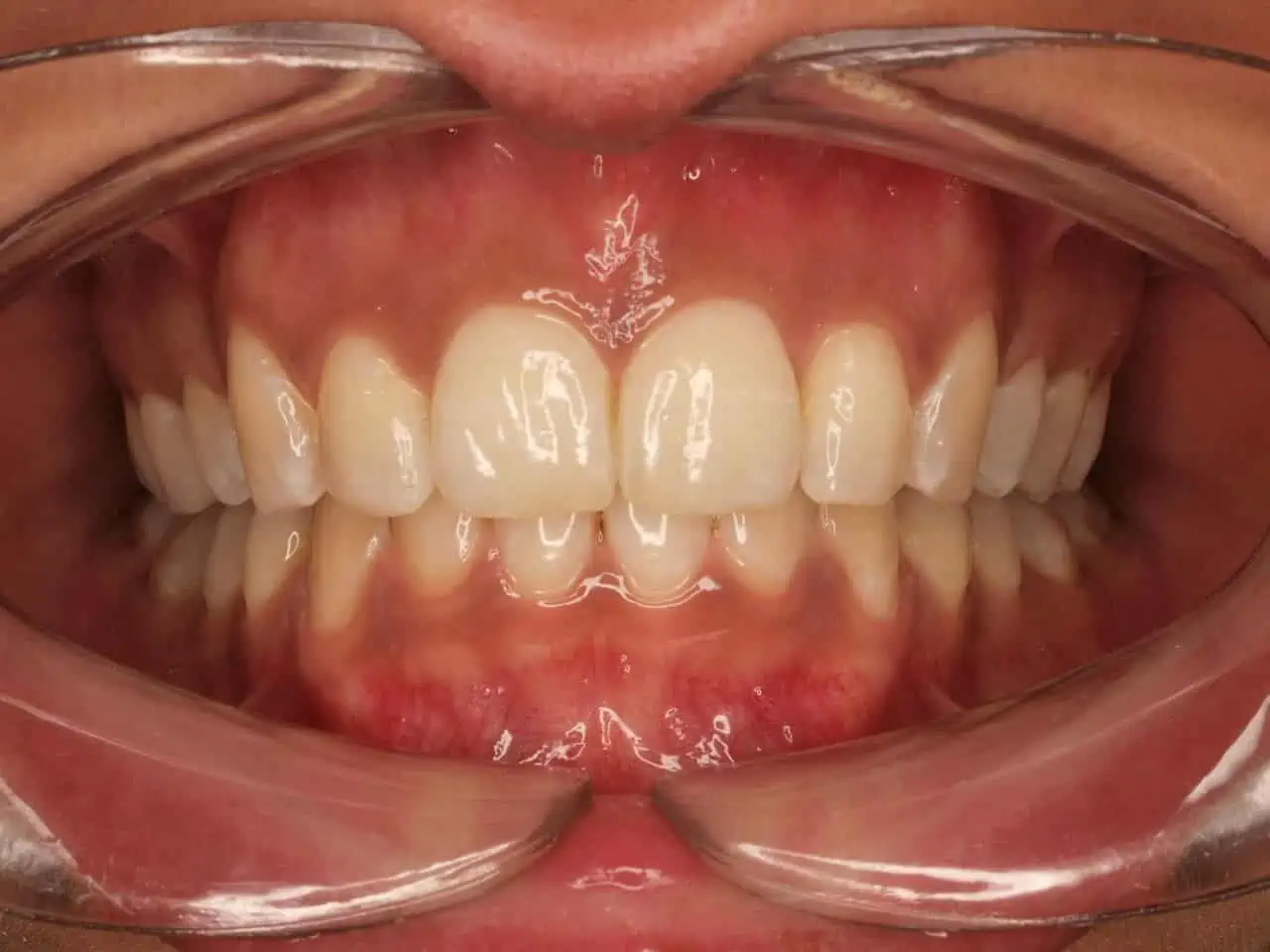How much do braces cost in the UK? You can expect to spend anywhere from £1,500 to £5,000 (or more), depending on the type of dental braces you get.
In this article, we will explore the cost of braces for adults in the UK, as well as the alternative methods of teeth straightening and their cost. We will also take a look at some before and after results from adults who have had braces, to help you decide which type of teeth alignment method is right for you.

- Virtually Invisible: Enjoy the discretion of clear aligners without brackets or wires.
- Home Convenience: Start from home with an easy assessment and custom aligner kit.
- Wear Time Flexibility: Optimal results with 22+ hours daily wear, changing aligners every 2-3 weeks.
- Cost-Effective: Save up to 75% compared to traditional braces.
- Safe Materials: BPA and latex-free for your health and comfort.
- Quick Results: See changes in just 4-6 months.
- Transform your smile today with NewSmile: Discover More
How much do braces cost in the UK?
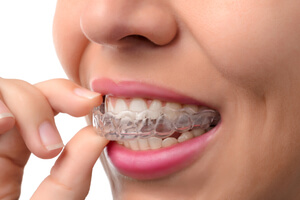
The cost of braces in the UK is very wide-ranging. Private braces cost £1,500 to £5,000 for most people, with the average cost of metal braces for adults around £2,000 to £3,000. Children up to age 18 can get braces for free with the NHS if deemed medically necessary.
Braces can appear to be costly. However, your new smile ought to endure forever as long as you adhere to the doctor’s consideration guidelines whenever you’ve had braces.
What’s more, if you follow up on your post-braces care plan appropriately, the investment will last a lifetime. So instead of thinking of it as spending a lot of money all at once, you can picture it as a lifetime of benefits.
Dr Azariy Yusupov, DDS, Amazing Smiles Orthodontics
What do private braces cost in the UK?
Private braces cost in the UK can vary significantly depending on the type of braces you choose and the complexity of your case. Some types of braces may be less expensive than others. The overall cost of treatment can also be affected by the length of treatment and any additional procedures that may be needed.
The cost of braces for adults is one of the things that prevents many people from seeking treatment.
Here you can see roughly how much different types of dental braces cost for adults and teens with private orthodontic treatment in the UK. These prices assume that both the upper and lower teeth are treated. Higher costs may apply if particularly complex work is required.
Type of Appliance | Approximate Price |
Invisalign | £3,500 - £5,500 |
At-home aligners | £1,300 - £1,600 |
Lingual (incognito) | £2,000 - £10,000 |
Ceramic | £2,000 - £6,000 |
Self-ligating (including Damon) | £1,500 - £6,000 |
Traditional metal | £1,500 - £3,000 |
Since metal braces cost less than clear and white ceramic fittings, a common solution is to use ceramic or clear brackets for the top front teeth (which are most visible), then have cheaper metal braces on the remaining teeth which usually stay out of sight.
However, if you really don’t want it to be obvious that you’re wearing braces, clear aligners like Invisalign offer the best balance between appearance, cost and efficiency.
If you need help covering the cost of braces, there are various ways to finance dental work.
Now that you know roughly how much braces cost in the UK, let’s discuss how braces work and the different types available.
What are the different types of braces for teeth?
There are several different types of braces, including metal braces, ceramic braces, lingual braces, and clear aligners. Each type has its own unique features and benefits. The most suitable option for an individual will depend on their specific needs and preferences.
Invisible braces / clear aligners
Invisible removable teeth straighteners are a completely different alternative to conventional metal braces. They use a series of clear plastic aligners which fit over your teeth and guide them into their correct position over time.
The official term for this method of teeth straightening is ‘clear aligners’, but you’ll most often hear them referred to as ‘invisible’ or ‘removable’ braces.
There are several brands of clear aligner braces in the UK Smile White, NewSmile, Invisalign, ClearCorrect, Straight My Teeth, and Diamond Whites. Invisalign is a very popular brand, but they are, however, also one of the most expensive brands of clear aligners on the market. Smile White offers the same treatment as Invisalign, but it’s more affordable!
Learn about our top picks for invisible braces and clear aligners in the table below!
We recommend speaking to your dentist before making any decisions on which orthodontic treatment is right for you.
- Up to 80% cheaper than Invisalign
- Buy now, pay later in interest-free instalments.
- Rated 4.5/5 on Trustpilot
- Starting at just 625 for single-arch treatment!
Caspersmile offers a convenient at-home solution for teeth straightening with their clear aligners. You can achieve a perfect smile in 3-5 months, wearing the aligners for 22 hours a day.
Caspersmile’s treatment is overseen by UK-licensed dentists, ensuring professional guidance throughout the process. The treatment starts with an at-home impression kit or a visit to a scan center, followed by a 3D preview of your future smile.
Every treatment comes with free teeth whitening, so you can brighten your smile while you straighten it!
- Hybrid in-office and remote treatment
- In-person visits with your orthodontist for safe, effective treatment
- Treats even complex cases of misalignment
- Various pricing options
Discover the flexibility and effectiveness of Impress Invisible Braces, the hybrid orthodontic solution that blends in-person care with the convenience of remote appointments. Suitable for both kids and adults, Impress offers a range of treatment options designed to cater to various needs, from mild to severe cases of misalignment. With the initial consultation happening in person, you’re assured of a tailored treatment plan that can address even the most complex orthodontic issues.
Impress Treatment Plans:
- Impress Super Light ($6,999): Perfect for mild cases, this plan promises results in up to 3 months, making it the quickest route to a better smile.
- Impress ($4,599): Designed for moderate cases, this option aims to perfect your smile within 4-10 months.
- Impress Plus ($5,599): Tailored for moderate cases requiring a bit more time, this plan spans 11-14 months.
- Impress Advanced ($6,999): The go-to choice for complex cases, offering comprehensive treatment over 11-24 months.
- Teens ($4,599): Specifically designed for teenagers, this plan addresses mild cases within 4-10 months, ensuring a confident smile during those crucial years.
- Impress Kids ($4,599): Offering orthodontic treatment for children, this plan covers a period between 8-18 months, setting the foundation for a lifetime of healthy smiles.
With flexible payment plans available, starting your journey to a perfect smile has never been easier or more accessible. Whether you’re looking for a quick fix or need extensive treatment, Impress Invisible Braces provide a tailored solution that meets your needs and budget. Click below to get started!
- Free retainers and whitening
- Nighttime aligners available
- 0% interest finance options
£1,395£1,295 or £83.33/month
NewSmile is a Canadian company that brought its clear aligners to the UK market in 2022. NewSmile aligners are made from the clearest material and the company offers excellent service at the best price.
They don’t have any physical locations, so you’ll need to purchase an aligner kit to get started. One of their Impression Specialists will guide you through the process on a video call when you’re ready.
NewSmile aligners are very affordable, costing just £1,395 (currently discounted to £1,295). But even better, this price includes whitening foam to use in your aligners, plus your first set of retainers!
Choose their daytime package for treatment in 4-6 months, or nighttime aligners for a more discreet treatment that takes 8-10 months. Both options come with 0% interest payment plans available.
NewSmile aligners are affordable clear aligner treatment that can help you straighten your teeth at home. They are the clearest aligners around and come with a very low price tag. These clear aligners cost less than Invisalign and are a very popular alternative treatment. NewSmile requires 22 hours of wear every day and the treatment typically lasts around six months.
Treatment with NewSmile starts with a quick online assessment to let you know if you are a suitable candidate. Most at-home clear aligner treatments, including NewSmile, are suitable for mild to moderate teeth straightening.
If you prefer not to wear aligners during the day, NewSmile offers night aligners. The treatment process is exactly the same, with the only difference being that you only wear your aligners at night.
Click here to read more about NewSmile’s night aligners.
Invisalign
If you choose Invisalign aligners, your dentist or orthodontist will scan your mouth to create a 3D image of your teeth. This will then be used to plan your treatment. Your tailor-made aligners should be ready within a month of this initial consultation.
As well as their braces for adults, Invisalign also produce a special kind of aligner brace for teenagers. This system is designed with features specifically to help teenagers get the most out of wearing them.

Invisalign treatment is suitable for a wide range of orthodontic cases but they aren’t right for everyone. If your orthodontic case is more complex, then Invisalign aligners may be a good option, but if your case is milder then it may be worth looking for a cheaper alternative.
The average Invisalign treatment takes 12-18 months, but it can be shorter or longer depending on the degree of correction required.
Invisalign aligners are completely removable which means you can clean and floss your teeth as normal, decreasing the chances of tooth decay and gum disease while you’re wearing them.
In short, removable braces from Invisalign offer efficient and convenient teeth straightening that’s very hard for other people to notice. However, Invisalign treatment may be unaffordable for some people, which is why many often prefer more affordable treatment options like Smile White.
Our guide to invisible braces has more information on this treatment and costs.
Once you’ve been determined to be a suitable candidate for treatment, you will be sent an impression kit to make your impressions and send it back so you can receive your 3D Treatment Preview. You’ll then receive a new set of aligners every two weeks and you’ll also receive free whitening treatments.

Keep your smile perfectly aligned with NewSmile’s affordable and convenient retainers. Choose a plan that fits your lifestyle and ensures your teeth stay in place after braces!
- Plan options: Single set purchase or an annual subscription for regular updates
- Retainer types: Choose from regular or extra thick for additional durability
- High standards: FDA-approved BPA-free plastic
- Free shipping: Free delivery on all orders
- Cost-effective: Save up to 50% compared to clinic prices
Inman Aligners
Inman Aligners are similar to clear aligners as they are made from a clear plastic material, and are removable.
However, they are also made up of metal springs and bars which make them visible when worn. This also makes them quite bulky to wear as the clear plastic envelops the metal parts as well as covering your teeth.
These are suitable for people who only need to make small adjustments to their front few teeth. It isn’t possible to treat the entire mouth with this appliance, and the cost of Inman Aligners becomes less competitive with this in mind.
Metal braces
If you think there is only one type of metal teeth brace, you’re in for a surprise. Yes, traditional fixed braces are still around and are probably the best option if you want cheap braces. But there are other styles to consider, which offer different benefits.
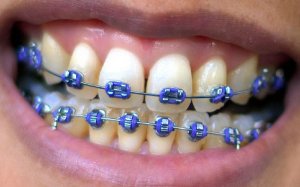
Traditional metal teeth braces
Even plain old metal fixed braces have come a long way from the ‘train tracks’ you or your parents may have experienced at school. They have become lighter, smaller and less noticeable as technology has improved.
Having these braces fitted takes 1-2 hours. The process itself shouldn’t hurt but it’s normal for teeth to feel sore after the initial fitting and after each adjustment.
Treatment using a conventional fixed appliance usually takes 12-24 months. During this time you’ll be at increased risk of tooth decay so it’s important to take good care of your teeth and clean your braces carefully.
What are metal braces made of?
The metal brackets used in fixed metal braces are usually made from high-grade stainless steel, sometimes combined with titanium. These brackets are attached to each tooth and a flexible metal wire, made from stainless steel and other metals, is threaded through each one.
Small rubber bands or metal ties are used to secure the wire. By tightening the wire in different places, orthodontists can manoeuvre teeth into the desired position.
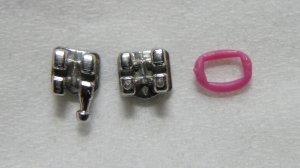
Other components of metal teeth braces may include:
- Larger elastic/rubber bands or chains are used to connect different teeth (from top to bottom) and pull them in certain directions
- Metal bands (orthodontic bands) placed around some molars to help with straightening
- Some kind of headgear that must to be worn at night to aid treatment (usually only when significant correction is required)
For teens (and even some adults!) one bonus with this style of brace is you can choose the colour of the elastic band used on each of the brackets. Coloured braces at least allow you to make a style statement while your teeth are being fixed. Another advantage is that metal fixed braces cost less than most other styles – and may be available on the NHS.
Self-ligating braces
Self-ligating braces are a different type of metal brace designed to make braces treatment faster and more comfortable. In terms of outward appearance, self-ligating braces are much the same as conventional braces in that they use a bracket and wire system.
However, uniquely designed brackets are used to allow free movement and self-adjustment of the wire inside the brackets instead of using elastic bands or metal ties to keep the straightening archwire in place.
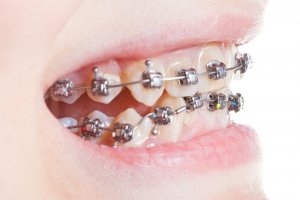
Some brands, such as Damon, have a clear option with transparent brackets for patients who are more image-conscious.
The self-tightening system used in Damon braces combined with advanced technology heat-activated wires means that the process of aligning teeth is relatively gentle.
With traditional brackets, patients usually experience pain or discomfort after each adjustment, but self-ligating braces are constantly adjusting at a much steadier pace.
The lack of rubber bands in this style of brackets means they are more hygienic, too. The brackets are designed to hold onto less food than the traditional style.
Self-ligating metal brackets can also work faster than traditional ones because they are more efficient at moving teeth. This, along with the fact that they require fewer checkups with your orthodontist, makes them one of the more affordable braces for teeth.
Lingual braces
For those seeking a discreet method of teeth straightening, an alternative to traditional braces is lingual braces. Unlike standard fixed metal braces, lingual braces are positioned behind the teeth, facing inward, making them barely noticeable from the exterior.
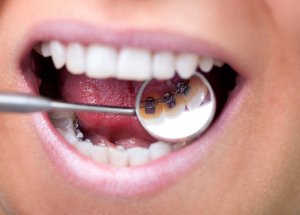
Lingual appliances, also referred to as ‘hidden’ or ‘Incognito’ braces (the latter being a brand name), consist of brackets attached to the inner surface of the teeth. These brackets can either be standard fittings or custom-moulded to the shape of each tooth, with the latter option being notably more expensive.
Although lingual braces are still visible when the mouth is wide open, they are not immediately apparent to observers. However, due to the challenging placement of lingual brace brackets, cleaning can be cumbersome, and adjustments may take longer compared to conventional braces. Additionally, the position relative to the tongue can lead to more pronounced speech difficulties.
Moreover, the cost of lingual braces, especially if the brackets are custom-made for each tooth, is higher than that of traditional styles. Despite their initial appeal, it’s essential to carefully weigh the advantages and disadvantages, especially when comparing them to clear aligners.
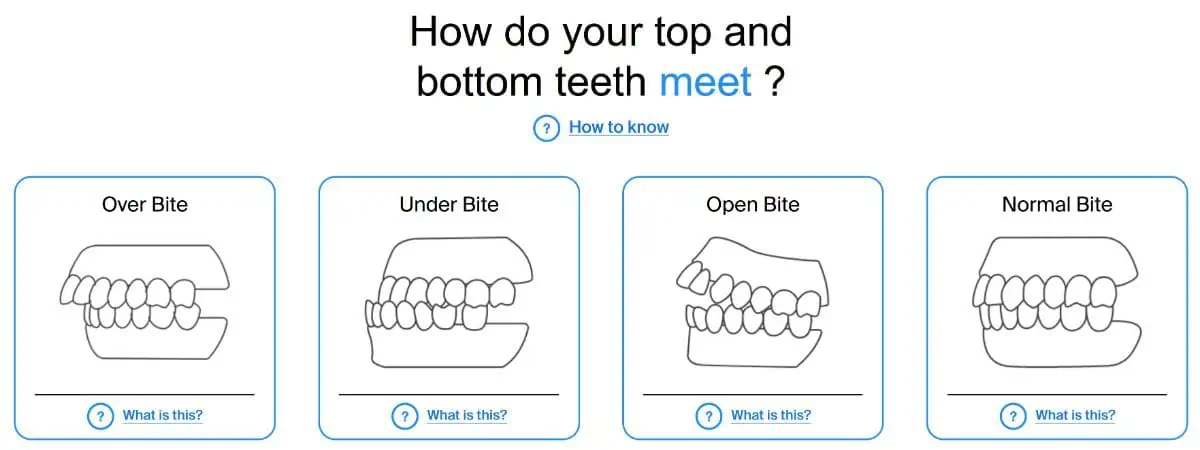
Ceramic braces
The brackets for ceramic braces are made from a material that’s either clear or the same colour as teeth, making them less obvious than conventional metal braces. The wire used to connect the brackets can also be tooth-coloured.

Because these work in the same way as traditional braces, they are just as effective. This does also mean that they carry the same potential for discomfort.
The main downside of clear or white braces is that the elastic bands used on them can stain easily if not cleaned properly. The material used also makes them more expensive than the average cost of metal braces.
For many people, ceramic braces like Clarity braces, or Damon braces provide a good balance between cost, speed and appearance. Transparent brace brackets are not noticeable from a distance and are less distracting close-up than metal braces.
Some ceramic braces are slightly more expensive, such as Radiance Plus which is the most luxurious option. The brackets are completely clear and are made from polished sapphire, making them stain-resistant and more comfortable due to the polished rounded edges.
However, even the clearest ceramic brackets are more noticeable than clear aligners, so it’s worth discussing the pros and cons of each with your orthodontist.
How do braces work?
Orthodontic braces come in various types, each of which functions slightly differently, but all with the common goal of correcting misalignment of the teeth and jaw.
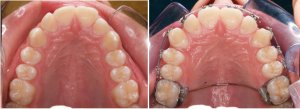
There are four main reasons why your dentist or orthodontist may recommend you have dental braces fitted:
- Your teeth are crooked, crowded or protruding and need to be realigned
- You have gaps between your teeth that need to be closed
- You have a malocclusion (e.g. overbite or underbite), meaning the relationship between your upper and lower teeth isn’t quite right and this is affecting your bite
- After losing your baby teeth, there isn’t enough space for adult teeth to grow through properly
If these problems are left untreated they can lead to:
- TMJ pain
- Periodontal tissue damage that could lead to loosening of teeth
- Difficulty eating
- Difficulty cleaning teeth properly, resulting in further dental problems
- Increased chance of damage to prominent teeth
- Headaches from jaw and muscle strain
- Speech impediments
- Self-consciousness with the appearance of teeth
Who can have orthodontic braces?
Orthodontic braces can be worn by people of all ages, as long as their teeth and gums are healthy. Children, adolescents, and adults can all benefit from wearing braces to correct problems with dental alignment.
Treatment may be more effective at certain stages of development, so it is generally recommended that children start wearing dental braces between the ages of 10 and 14. Teeth straightening works best when the teeth and jaw are still growing, but treatment won’t usually begin until most adult teeth have come through.
However, braces can still be effective at any age. The British Orthodontic Society reported in June 2020 that 80% of its members had been fitting more adults with braces, up from 75% in 2016. And around 200,000 adults and teens get orthodontic treatment per year.
Braces aren’t just for kids anymore. More than 20% of people with braces are now adults and 1.4 million Americans over the age of 18 have braces – a 40% increase since the late 80s.
Adults are getting braces for a variety of reasons: to achieve a better smile or to fix the effects of conditions like gum and bone loss, tooth decay or jaw joint pain.
But braces aren’t for everyone and you have to make a commitment. Here are a few questions to ask yourself and your orthodontist before you begin adult orthodontic treatment:
- Are you willing to put up with minor changes in your appearance during treatment?
- Can you abstain from certain sticky and hard treats?
- Are you willing to endure some tenderness in your mouth and teeth after adjustments?
- Will you be able to cooperate with the instructions and suggestions of your orthodontist?
- Are your treatment expectations realistic?
Dr. Clarke Stevens
Some Adults get braces to keep their teeth healthy, but often, it’s really about wanting a nicer smile.
Even though regular braces are still common, more and more adults are going for clear aligners. They’re a less obvious way to straighten teeth without making a big fuss about it.
One condition of having braces is that your teeth are in relatively good condition and you maintain good oral hygiene.
If your teeth have already been damaged by decay, you have gum disease, or you have had extensive restorative work such as crowns, you may not be able to have all types of orthodontic treatment. In this case, you could consider veneers or other cosmetic dental work to improve the appearance of your teeth.
But before making this decision we recommend booking a consultation with your dentist to explore the best option for you.
What are the alternatives to braces for teeth straightening?
There are several alternatives to braces that can be used to straighten teeth, including clear aligners, palatal expanders, and orthodontic headgear.
In most cases, it’s possible to realign teeth without having metal glued to them – which is what most people consider braces to be. Clear aligners are one way to do this.
However, some people want to avoid braces altogether, can’t visit a dentist’s office regularly, or simply can’t afford the treatment. Fortunately, there are other ways to straighten teeth without braces – at least in certain cases.
For instance, veneers can be used to improve the appearance of crooked teeth, and composite restorations can help close gaps in teeth.
Then there is the option of home teeth aligner kits, which are usually cheaper than getting braces at the dentist but have some limitations and risks.
If you are considering removable teeth straighteners and want to know more, read our article on the best teeth aligners in the UK.
Adult braces before and after
Orthodontics can achieve some pretty amazing transformations. The time-lapse video below shows how a variety of patients’ teeth looked before and after braces treatment.
Your teeth after braces will be better aligned so you can eat and take care of them more easily. When you have crooked teeth the spaces between them are harder to clean which allows increased plaque accumulation over them. So getting braces may reduce your chances of cavities later in life.
Orthodontia should also improve the aesthetics of your smile. These ‘before and after braces’ photos show the transformation that can occur:
Orthodontic appliances usually get to work quite fast; the third example above shows teeth just nine weeks after the initial fitting. But even if your teeth start to look better after just a couple of months, it’s likely your treatment will need to continue for a while longer to get your teeth moved into their final position.
We have a separate page of Invisalign before and after pictures which may also be of interest.
Wearing retainers after braces
After your braces come off, your teeth won’t necessarily want to stay in their new, straighter position. A retainer will help keep them in place. The length of time you have to wear one will depend on your individual circumstances – your dentist will advise you on this, however this is often a lengthy period.
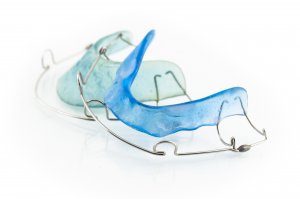
If you’ve only had your front teeth straightened, you may be able to get a fixed retainer. This is a metal wire that’s glued to the back of your teeth to keep them in place.
The other option is a removable retainer, and these come in a couple of different styles – Essix (clear) and Hawley (pictured). They might need to be worn during the day, at least at first, but can easily be taken out for special occasions and to eat. On the downside, they’re easy to lose and expensive to replace.
Whichever type you choose, you’ll need to clean your retainer properly to prolong its life. Read more about how retainers work and the different types available in our full guide to retainers.
What’s it like wearing braces as an adult?
Getting braces as an adult can be a whole different ball game compared to getting them as a teenager, since adults often have different worries and expectations. Despite this, the basic process of having braces is pretty much the same for adults and kids.
In many countries, including the US, braces for adults can be quite pricey, even with insurance. This has turned them into a bit of a status symbol. This idea hasn’t caught on as quickly in the UK, where there’s still some negative perception around wearing braces.
These days, it’s becoming more normal for adults to go for braces later in life. It could be because they missed out on it as a kid or simply because adult braces can cost a pretty penny in the UK with private treatment.
“Many adults who have undergone orthodontic treatment report higher levels of self-esteem and their quality of life is often significantly improved”
It’s still understandable for adults to worry about being treated differently at work, being teased by friends, or being viewed differently by potential partners as a result of wearing braces. This is one of the reasons why alternatives such as removable aligners and clear braces are so popular.
Invisible braces not only make it easier to eat but can be taken out for short periods – for example, important meetings – if the wearer is particularly self-conscious.
On a practical note, some adult brace-wearers report difficulties with speaking and eating at first, but soon become accustomed to their new appliance and find ways to adjust. Most people get used to wearing braces within a month, and no longer notice them after six months or so.
Cleaning around fixed braces takes a little extra time, but there are special tools such as orthodontic floss, interdental brushes and oral irrigators which can make the job easier.
Do adult braces hurt?
If you get dental braces as an adult you’re asking your body to break down bone in your jaw that holds your teeth in their current position, then re-grow securing teeth in their new position. The following video shows how this happens:
So yes, it’s normal to feel some discomfort – especially in the days following each visit to the dentist or orthodontist where your brace is adjusted. There’s a chance you may also experience some irritation to your cheek tissue, which can lead to mouth sores.
However, in return for a year or two of occasional discomfort, you get a smile you’re confident to show off for the rest of your life.
Some people need to get dental spacers before braces to create some space around certain teeth, especially for fitting molar bands. Spacers usually cause some pain and discomfort for the first day or two after fitting.
Here are some ways to stop braces from hurting:
- Take over-the-counter painkillers to ease any occasional soreness and aches
- Eat soft foods such as soup, eggs, pasta, mashed potato and yoghurt if you experience discomfort when biting
- Use dental wax to cover any brackets or wires that are irritating your mouth
- If you do develop mouth sores, avoid touching them with your tongue or fingers as this will make them worse
- Anaesthetic mouth gels can be used to numb painful areas – this can be especially useful at night if you’re having trouble sleeping
- Rinsing your mouth with warm salt water will help ease oral pain
If you experience severe pain from wearing braces or a wire comes loose and is at risk of causing injury to part of your mouth, you should contact your dentist or orthodontist to make an urgent appointment.
Eating restrictions
While there are some foods you may avoid simply for comfort, there are others that are prohibited altogether if you have a fixed appliance.

Invisible aligners offer most flexibility with eating as they can be completely removed – but remember you must clean your teeth before putting them back in again.
Your orthodontist will tell you which foods to avoid eating with fixed braces. These usually include:
- Hard foods like nuts and boiled sweets
- Foods you bite into like apples, raw carrots, crusty bread and corn on the cob
- Sticky foods like caramel and chewing gum
- Crunchy foods like popcorn, crisps and ice
- Chewy foods like gummy sweets, bagels and tough meats
You can also cause damage just by biting on hard things like your fingernails or the end of a pencil, so you must be mindful of what you put in your mouth.
If your braces get damaged while you’re eating you may not even realise it, and this can prolong your treatment. You may have to pay for certain parts to be replaced, too. These are both good reasons to follow the instructions from your dentist!
You can read our full guide about what you can eat with braces to find out more.
How do I know if I need orthodontic work?
After reading all of this, you might be wondering “Do I need braces?“. The simple answer is that even if there is no medical need, there is nothing stopping you from getting cosmetic teeth straightening.
So if you’re unhappy with how your teeth look and you think adult braces would help, go ahead and book an appointment to find out more.
If you think you’re eligible for braces on the NHS you’ll need to make an appointment with your dentist who will then refer you to an orthodontist. We have a separate guide on NHS braces if you’d like to learn more.
With private treatment, you can skip straight to having a consultation with your chosen orthodontist or dentist.
This video from the British Orthodontic Society explains more about your choices when it comes to braces:
Should you decide you want a certain brand for you or your teenager, such as Invisalign or Damon, you will need to search for orthodontists or dentists near you who offer that particular system.
Finding an orthodontist with the best braces prices near you
First and foremost it is important to check if the dentists or orthodontists in your area are experienced, well-qualified, and have opening hours to suit you. Asking family and friends for a recommendation is also a good idea.

Braces prices in the UK will vary across different regions and from one dentist to another, so it’s worth shopping around to get an idea of costs.
An orthodontist won’t be able to provide a final quote until they have examined your teeth during a consultation, which may itself incur a small fee. Many dentists offer payment plans to make treatment more affordable.
Be sure to check exactly what is included in your quotation and what you’ll have to pay for separately. Consider things like tooth extractions, retainers, mouthguards, and ongoing check-ups after your braces are removed.
Also, remember that you’ll need to travel to your dentist for regular check-ups, so it’s more convenient to find one located near your home or office.
Conclusion
It’s never too late to take the first step towards a more confident smile. Now you understand how much different kinds of dental braces cost in the UK, you just need to decide which type will suit you best. This probably comes down to a balance between price, comfort, appearance and results.
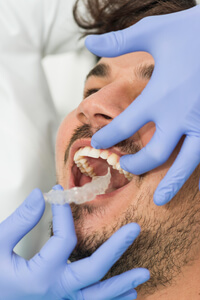
In summary, we can say that:
- Most teens and adults would prefer to avoid the ‘train track’ metal braces look.
- Ceramic braces are less obvious than metal, but only from a distance, and can be just as uncomfortable.
- Lingual braces have the ‘invisibility’ factor, but with a high price tag.
- Invisible aligners arguably provide the most comfortable, affordable and efficient straightening solution if you don’t want it to be obvious you’re wearing braces.
If you have a mild orthodontic case and like the idea of doing everything from the comfort of your own home then NewSmile might be right for you.
Speak to your dentist before making a decision on any treatment, so you can be sure you are choosing the best one for your needs.
Whatever you decide on, we hope this article has helped you understand all the options available.
FAQs
Do I need braces?
While only a dentist can assess if you medically need braces, it’s important to distinguish between medical necessity and a desire for cosmetic improvement. Even if braces aren’t a medical requirement, some people opt for them to enhance their smile and address aesthetic concerns. Schedule a consultation for personalised advice based on your dental situation.
What are the best adult braces?
For effective results, metal braces work, though they’re not aesthetically pleasing. Adults seeking discretion often choose clear options like Invisalign or Smile White for a more subtle way to straighten teeth. Consultation with an orthodontist helps in deciding the best fit.
How long do braces take to work?
Orthodontic treatment can be as fast as six months if you only need minor tooth movement. However, for more complex cases it can take 18-24 months and perhaps even longer.
How much are braces for adults UK?
The cost of braces in the UK is very wide-ranging. Private braces cost £1,500 to £5,000 for most people, with the average cost of metal braces for adults around £2,000 to £3,000. Children up to age 18 can get braces for free with the NHS if deemed medically necessary.
How are braces put on?
The orthodontist precisely applies a small bracket to each tooth using cement. Once all brackets are in place, a wire is threaded through them and small elastics keep the wire in place.
How long does it take to put braces on?
It takes around an hour for each jaw to be fitted. Since it can be uncomfortable keeping your mouth open for this long, your orthodontist may spread the process over two appointments. This also gives you time to get used to the first arch before you have the second one fitted.
Does it hurt getting braces fitted?
It might be a bit uncomfortable, and your teeth will probably feel tight once the wire is in place, but the fitting process itself shouldn’t cause you any pain.
Does it hurt getting braces off?
Your dentist will remove your elastics one last time and then use special dental tools to break the brackets off your teeth. You will feel some pressure, but it shouldn’t hurt.
Can I do teeth whitening with braces?
You should check with your orthodontist first to make sure that none of the whitening gel ingredients will harm your braces. If you have fixed metal braces, it’s best to wait until they come off.
Dentistry Online: Orthodontic treatment increases in popularity amongst adults. Consulted 3rd January 2023.
British Dental Journal: Number of UK adults seeking braces is rising. Consulted 3rd January 2023.
British Orthodontic Society: As orthodontic practices re-open new statistics reveal rise in adults seeking tooth straightening treatment amid concern over ‘DIY’ treatment. Consulted 3rd January 2023.
Fisd.oxfordshire.gov.uk: Braces and orthodontics. Consulted 9th May 2023.
Prices stated are indicative only and are based on publicised treatment prices at dental clinics across the UK.







